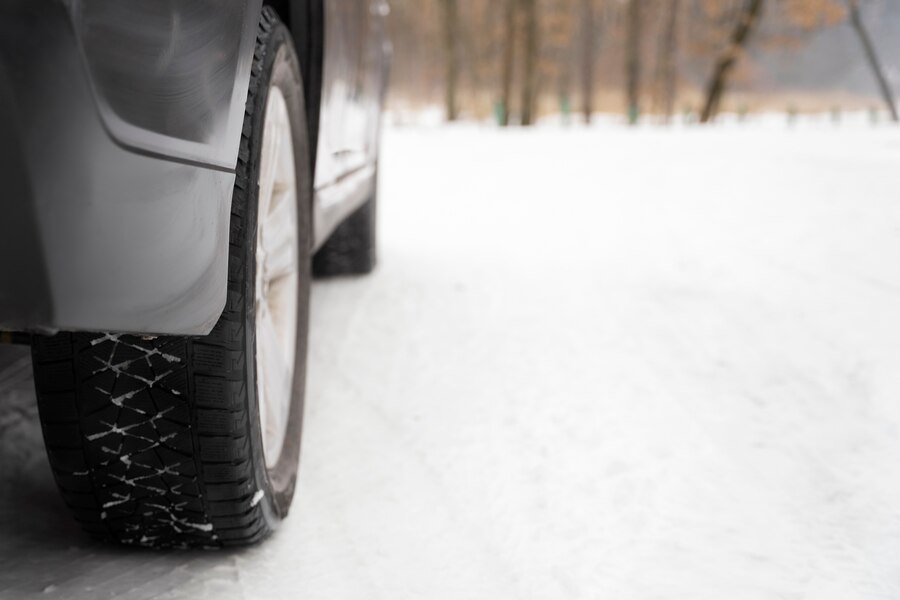How To Choose The Right Winter Tires For Your Driving Needs
Sledding, ice skating, and snowball battles are just a few of the enjoyable activities available during the winter season. However, there’s more to it than that: difficult driving conditions.
Normal tires’ rubber becomes harder in lower temperatures, lessening its capacity to adapt to the road surface. Additionally, it makes it harder for cars to stop when the brakes are used, extending the distance that they can slip and skid.
Winter driving is not the best season for all-season tires. They also have a less pronounced tread pattern, which causes them to struggle on uneven roads with deep snow or areas of ice. As the snowy season approaches, it’s crucial to begin considering replacing your summer or all-season tires with winter ones.
Small channels and grooves in winter tires help to divert melted snow to the side. Additionally, they have special tread patterns called sipes that provide greater traction by biting into ice and snow. It facilitates the tires’ continued clasping contact with the pavement.
All-season tires fall short of winter tires when it comes to safe handling and short-distance braking on slippery or snowy roads. Winter tires are made especially to function better in snow and ice.
Here is how to choose the right tires for winter driving.
1. Evaluate Your Tire Size
One of the first things a salesman in a store will ask you is what size tires you have, so be sure you know. The size of your summer and winter tires ought to match. If you’re considering winter tires for your vehicle in Toronto, be sure you have the appropriate tire size.
This guarantees top efficiency and security on winter roads. To locate the ideal fit for your car and driving requirements, make sure to ask about the discounts and possibilities that are available for winter tires for sale in Toronto.
You can determine the size of your tires by checking the sidewall. The code is P225/60 R17. The tire code can be interpreted as follows:
- “P” represents Passenger. It signifies that the tire is intended for use in passenger cars. Additionally, “LT” is used for light trucks.
- The tire’s width, expressed in millimeters, is “215”.
- The aspect ratio, or the ratio of the sidewall height to the tire’s width, is “615.”
- “R” designates the radial structure in the tire.
- The wheel or rim’s diameter in inches is indicated by the number “16”.
- The load index, which equals the maximum weight the tire can support, is “9”.
- The maximum sustained speed at which the tire is rated is indicated by the letter “S” on the tire.
Choosing all-season tires that are the same size allows you to preserve your car’s handling and balance.
2. Studded Compared To Performance Winter Tires
Metal studs are inserted into the tread of tires marked with studs. The studs penetrate the ice to improve traction in icy and hard-packed snow conditions.
These tires are the best options in places like Montana, North Dakota, Minnesota, and parts of Alberta and Quebec in Canada that receive a lot of snowfall.
Studded tires help you stop and maneuver more safely in severe driving conditions. However, with light snowfall, they can also create ruts or potholes on the road surface.
Conversely, performance winter tires work well in places with mild winter temperatures. These regions include the cities of Vancouver and Toronto in southern Canada, as well as Chicago, Denver, and Boston, where snow and slush are typical.
Ultimately, the local temperature, the state of the roads, and your driving style will determine whether you choose performance or studded winter tires.
Make sure you ask local authorities about using studded tires. While some places have outright banned them, others only allow them during certain winter months.
3. Pick the Right Depth and Pattern
The fundamentals of choosing a tread pattern are simple: the stronger the grip on ice and snow, the more abrasive the design, and the wider the channels between the treads.
The tread depth of new snow tires is typically 10/32 to 12/31 of an inch—the distance between the top and bottom of the channels between each tread block.
In other words, less snow is likely to accumulate, affecting the tread depth’s ability to grip the road. This tread pattern could produce additional road noise at high speeds. However, the high grip is still crucial if you drive in frequently snow-packed areas.
Drivers who frequently use roads cleared of snow may choose a tread design that has been smoothed down, which reduces road noise.
4. Three Peak Mountain Snowflake
It takes work to choose the correct tires for winter driving; drivers also need to pay attention to the Three-Peak Mountain Snowflake emblem on the side wall.
The tire is appropriate for snowy and icy situations if it satisfies particular performance standards for winter traction, as indicated by the 3PMSF mark. The tire bears a M+S emblem, indicating that it is designed to function effectively in mild winter weather.
Every 3PMSF tire is designed with a particular tread pattern and rubber composition ideal for slick conditions. They greatly shorten a car’s stopping times on roadways coated in snow and are malleable in sub-freezing conditions.
In certain snow-covered areas of the US and Canada, the use of 3PMSF tires is mandated. Examine regional laws before planning your subsequent trip.
5. Insist on More than One Option
Before choosing tires for your winter journeys, ask about multiple options. There are many trade-offs when choosing the finest winter tire for your driving style and region. Examine every one of them, including the following:
- Grip
- Noise
- Amount of snow throughout the season
- Mileage
- Anticipated travel destination
- Yearly mileage
- Warranty
Winters can differ depending on where you reside. There are spots with freezing rain and regions with significant snowfall.
Winter tires might not be suitable for all vehicles. Tire size, load capacity, and speed rating are factors that must match a vehicle’s standards. Examining several choices makes it more likely that you’ll locate a tire at CarHub North York Chrysler that meets your vehicle’s needs.
Schedule a vehicle inspection to prepare your car for the winter months before you start driving on your new tires. Winter driving can be dangerous because it involves numerous situations that even seasoned drivers find difficult to handle.
Appropriate maintenance guarantees the best performance of your car’s vital parts, including the lights, brakes, batteries, and heating system. Avoiding car breakdowns on your next winter road trip can also help you save money by addressing minor problems before they become larger, more expensive repairs.
Final Thoughts
During the winter, selecting the appropriate tires can significantly impact your comfort and safety while driving. It’s crucial to thoroughly analyze your alternatives because there are a number of things to take into account. Before making your choice, make sure your performance or studded tires fit your driving style and local requirements.
Remember to put safety first by keeping your car in good condition and having it inspected by a professional before you drive on winter roads. Following these recommendations can help you drive more smoothly and safely throughout the winter.







